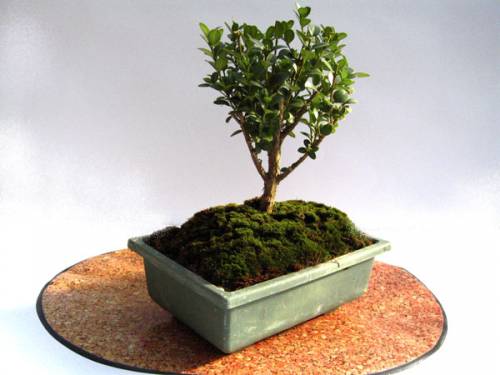Sugit or how it is still called Buxus, is an evergreen shrub designed for the design of a living hedge. It is enough just to find out due to the presence of small leaf leaves.
Content
Features of Samsita
Sugit is a plant that may have a trees growing up to 10 m in height or shrub. Most often it is used as decor and for industrial purposes, namely to obtain wood and landscaping. It is recommended that it is recommended to grown in warm climatic conditions, since it does not tolerate frosts. If the inhabitants of the harsh frosty climate acquire it, he feels great and indoors.
For growing in room conditions, breeders specifically brought certain varieties that have a motley and ordinary color: the Bolear type, evergreen and mellite. When disorders in care, the plant immediately resets the leaves.
From the bushes of the Samshat, you can create various geometric, ovoid, pyramidal, cone-shaped forms and unusual figures, while tall varieties are used to form flowerms, green scenes and vibrant hedges.
For borders, gardeners take glorosal species and beautifully combine the plant with flowers of various shades. Thanks to the use of the Samshat, which loves trimming, your garden landscape will acquire a complete and unique form.
Sugit: landing and care
Before growing the growing plant, it is necessary to purchase container seedlings of Samsit. Please note that they should be sufficiently bushy, and shoots and leaves with green. You should not buy plants having yellow leaves, as well as copies with bare shoots.
Recommendations:
- the sewage site should be chosen in cool with the lack of drafts place. At the same time, it should be perfectly covered with the sun;
- the soil for planting is desirable to take nutritious and loose;
- the plant must be regularly feeding, namely, with each watering during the active growing season, in winter - 1 time in 30 days;
- reproduce the plant can be seeds and cuttings;
- sugit is recommended to be abundantly and often spray with filtered soft water, because it does not like dry air;
- it is often not necessary to transplant it, this is done exclusively as it grows;
- in the process of transplant, the technology of pulling into a capacity of larger size is used;
- form a plant should be used with trimming, and the remaining cuttings are used for reproduction;
- susheshet cuttings are perfect with high humidity and in humid soil;
- in the conditions of the room, the plant blooms quite rarely and even less often forms seeds;
- with incorrect care, the sump can be amazed with milder worms, a shield and a spider tick;
- for such a plant, the root rotes are most dangerous.
Landing Samstita
As for the soil, it is absolutely comprehensive to it, but it is best to develop in a loose, well-fertilized and limestone. It feels greatly in sexualized and shady places, as well as on the summer sun, subject to shading for the winter.
Plant is recommended in the spring. In this case, it has time to root normally before the onset of frosts. If you make the correct transplant in the summer, then with regular spraying, watering and care, adult does not stop growing. The autumn landing is possible only 30 days before the occurrence of cold weather, if this happens later, the saplings are better to pepper on the shady site before the beginning of the spring.
Landing Rules:
- embark boxwood can be from spring to autumn. To do this, dig a trench that will be several times larger and deeper root system;
- must then be put on the bottom of 15 cm compost and mix it with garden soil;
- further boxwood extracted from seedlings and roots are straightened containers;
- planted shrubs should be in increments of 30-40 cm at exactly the same depth as they were growing in containers;
- irrigate.
cuttings of boxwood
At reproduction boxwood vegetatively, root from 80% -100% of the cuttings. During the summer grafting is usually determined by the state of young shoots - they need a little odrevesnet at the bottom. Autumn cuttings are cut in late summer or in early September. Their length should be between 5-10 cm. Backsheet remove and leave at the top two shanks. The slices should be done on the latter and under the first interstices. Further, they are planted in loose soil, which is made from a mixture of garden soil, peat and close the film. At constant watering cuttings okorenyayutsya after about 21 days.
Trim boxwood
Under mild climates, plant trimmed for the first time in April. In more severe - it is necessary to wait for the beginning of May.
By itself, boxwood develops rather slowly, so most gardeners are limited to easy adjustment of the crown and cut only new gains. If the plant is completely lost its shape, it can be cut and to the old wood.
Care boxwood
- Around October-November, you must produce abundant watering plants, which saturate it with moisture in the winter.
- It is also recommended that you mulch the soil under the bushes using peat or pine needles.
- After the onset of cold weather you can start shading boxwood. For this the plant is covered with plastic or wooden boxes with holes.
- Small boxwood hedges and borders can be covered in several layers of non-woven materials.
- Stam trees should tie to the supports, and fully cover non-woven fabric.
- In the spring, remove the cover and remove the snow from the plants and loosen it.
- Material removed in cloudy weather, but not completely. It is desirable to leave a boxwood one layer thereof. Only a week later the plants are released completely.
Boxwood video:

































